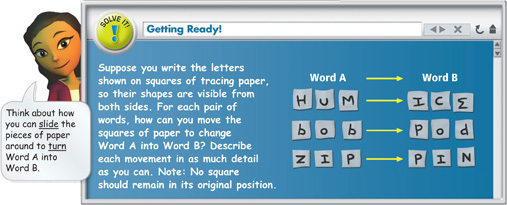9-1 Translations
Objectives
To identify isometries
To find translation images of figures
 Lesson Vocabulary
Lesson Vocabulary
- transformation
- preimage
- image
- isometry
- translation
- composition of transformations
In the Solve It, you described changes in positions of letters. In this lesson, you will learn some of the mathematical language used to describe changes in positions of a geometric figure.
Essential Understanding You can change the position of a geometric figure without changing its size or shape.
A transformation of a geometric figure is a change in the position, shape, or size of the figure. When you play dominoes, you often move the dominoes by flipping them, sliding them, or turning them. Each move is a type of transformation. The diagrams below illustrate some basic transformations that you will study.

|

|

|
| The domino flips. | The domino slides. | The domino turns. |
In a transformation, the original figure is the preimage. The resulting figure is the image. An isometry is a transformation in which the preimage and image are congruent.
Table of Contents
- 6-1 The Polygon Angle-Sum Theorems
- 6-2 Properties of Parallelograms
- 6-3 Proving That a Quadrilateral Is a Parallelogram
- 6-4 Properties of Rhombuses, Rectangles, and Squares
- 6-5 Conditions for Rhombuses, Rectangles, and Squares
- 6-6 Trapezoids and Kites
- 6-7 Polygons in the Coordinate Plane
- 6-8 and 6-9 Coordinate Geometry and Coordinate Proofs





